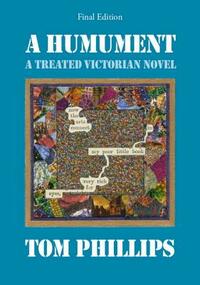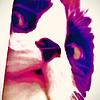Take a photo of a barcode or cover
GOD what a banger. It was shockingly steamy for the subject matter. Phillips is clever, fun, tender, and intense, and I loved every page. What a brilliant idea and what a brilliant execution.
As the first modern altered book, this was intriguing. However, I think it lost a lot of its appeal since it was a reproduction and didn't show all of the textures that the original would have contained. However, it gave a lot of ideas of what you could do with a "blank" page.
This book is more like a work of art than anything else, in my opinion. It is a labour of love spanning 50 years of revision, and the end result is beautiful. I don't think I will ever read another text like this again.
Oh, Humument, I want to love you and give you 5 stars. The artwork is simply amazing (5 starts), but the story of toge/prose was hit or miss for me (3 stars), so I guess we'll meet in the middle (4 stars).
Does one really read this? Well, certainly not the way one reads anything else. Ton Phillips has built his life's work around W. H. Mallock's discardable Victorian novel A Human Document. Phillips has created and recreated his Humument (mine's the 4th edition--each different) using Mallock's text as his canvass. He draws, sketches, and paints over the pages of the text, creating his own text through excision. Phillips' words then are only those words or parts of words in Mallock's text he chooses to leave untouched. The resulting text works as a series of abstract reflections--the text illuminating the image and the image illuminating the text. It functions unlike any other text I know, and Phillips dances brilliantly in his bizarre, self-imposed constraints. You can see pages here. He also translated Dante's Inferno and interspersed the text with treated pages of Mallock's text that offer commentary on Dante's work. Suffice it to say, I think that's pretty f'n cool.
This is a hard one to rate, and I have a feeling my opinion will change overtime. The author’s goal — of taking the techniques used in erasure poetry to craft a novel out of an existing text — is incredibly ambitious, and the idea itself makes this work admirable.
It’s difficult to say whether the author was successful. Reading this reminded me of “The Waste Land,” as it hints toward a narrative and characters, but never enough to actually fully follow what is “happening,” at least not without many, many rereads. Because I personally love “The Waste Land,” I enjoyed engaging with a text that messes with our understanding of how a novel can be written. There is some truly gorgeous verse in this book. But when I did try to engage with the text like I would with a typical novel, I found it to be frustrating. I know this is kinda of the nature of non-linear narratives, and I occasionally see some of the characters and story come through. But I just felt like there was something missing when it came to connecting these pages as a collective story rather than a book of poetry.
While the nature of this art form makes this book’s word-count short, I still felt like there was an issue of quantity over quality. Sadly, many pages felt like repetitions of one another. I felt like much of the text that was poignant (exploring sexuality, loneliness, love, etc.) got lost in when other weaker sections retreaded the same ground.
The author apparently displayed the pages in a gallery first, and that makes sense. The scale of what he created is likely more powerful as a physical display rather than having all the pages bound together as a singular story. And that maybe sums up how I feel about this book: wonderful art, and a some what successful attempt at a novel.
It’s difficult to say whether the author was successful. Reading this reminded me of “The Waste Land,” as it hints toward a narrative and characters, but never enough to actually fully follow what is “happening,” at least not without many, many rereads. Because I personally love “The Waste Land,” I enjoyed engaging with a text that messes with our understanding of how a novel can be written. There is some truly gorgeous verse in this book. But when I did try to engage with the text like I would with a typical novel, I found it to be frustrating. I know this is kinda of the nature of non-linear narratives, and I occasionally see some of the characters and story come through. But I just felt like there was something missing when it came to connecting these pages as a collective story rather than a book of poetry.
While the nature of this art form makes this book’s word-count short, I still felt like there was an issue of quantity over quality. Sadly, many pages felt like repetitions of one another. I felt like much of the text that was poignant (exploring sexuality, loneliness, love, etc.) got lost in when other weaker sections retreaded the same ground.
The author apparently displayed the pages in a gallery first, and that makes sense. The scale of what he created is likely more powerful as a physical display rather than having all the pages bound together as a singular story. And that maybe sums up how I feel about this book: wonderful art, and a some what successful attempt at a novel.
When I first stumbled across this in the library I was horrified at the thought of doing such things to a book (yes I am that much of a geek, it's okay I'm fine with this) but then I took a moment to read the story behind how and why Phillips did so and I must say I am a convert (and pleased that he has kept the original unscathed!). He has managed to breathe new life into an old work that would otherwise have been left forgotten on dusty shelves and in doing so has opened up a whole new genre of reading and style of art, all in one hit. Each page is superbly done and while the reading of this work is a little abstract, patterns quickly emerge and engross the reader/viewer in the overall beauty of the work. This is simply something you must try for yourself.
challenging
fast-paced
Plot or Character Driven:
N/A
Strong character development:
No
Loveable characters:
No
Diverse cast of characters:
No
Flaws of characters a main focus:
N/A
The pages are very beautifully designed but the story was confusing to follow. There were some very breathtaking moments though.
A really interesting undertaking, I'd love to see the latest edition. Not really something to sit down and read in a a short period as it's an arts project more than anything else so I've picked this up many times over the course of this year the way I do poetry.





